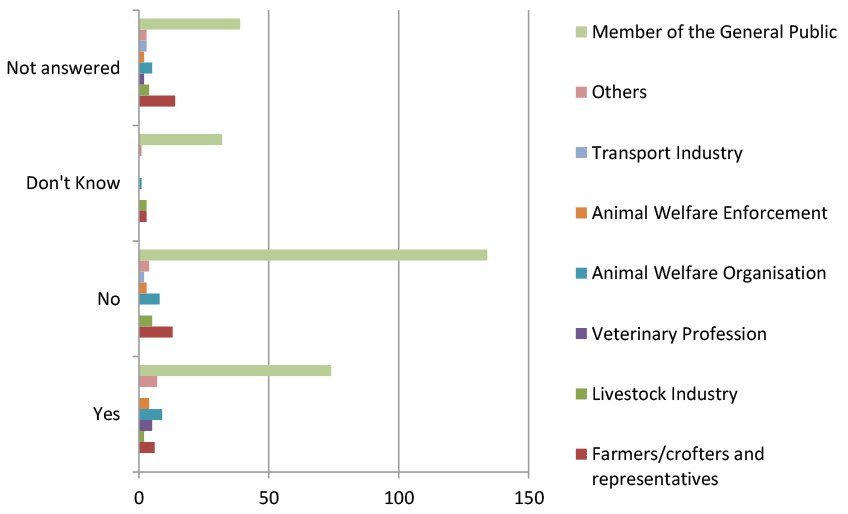Welfare of animals during transport - consultation: summary report
Analysis of the responses received to the full public consultation, between 4 December 2020 to 26 February 2021, of the Farm Animal Welfare Committee's opinion on the welfare of animals during transport.
Question 5
Do you agree with the Scottish Government’s position on the means of transport and proposed course of action? Please provide any further relevant information.
It is the view of the Scottish Government that a proportionate and risk-based approach towards the application of statutory regulation should also apply in relation to vehicle approval, certification and inspection. Currently inspections are required for vehicles transporting livestock on long commercial journeys of over eight hours.
We agree that in relation to livestock, poultry and horses we could reconsider where the boundaries of statutory regulation of vehicles should lie, and what those specific risk-based and proportionate regulatory requirements should be. This could include considering to what extent different requirements should apply to commercial journeys and to other journeys.
We agree that a suitable transition period should apply to any changes. We agree that the quality of a journey can affect the welfare of animals during transport and that accelerometers can provide useful additional data and evidence relating to journey quality.
We consider that accelerometers could be treated as one aspect of vehicle specification, along with the possibility of extending the requirement for GPS tracking devices to be fitted. The case for fitting GPS devices and accelerometers (to new vehicles or existing vehicles) should be covered by a consideration of what risk-based and proportionate statutory regulation should apply to vehicles used.

Of the 316 responses to this question, 33.9% were in favour of the Scottish Government’s position on the means of transport and proposed course of action. 53.5% were not in favour and 12.7% did not express a view.
There was support in comments offered for any future measures to cover non-commercial transport also as “welfare issues can arise any movement” (Dumfries & Galloway Council). However, some respondents commented that a blanket approach for all vehicles is appropriate, with consideration that “towed livestock trailers” could be excused (Argyll & Bute Council).
A reasonable number of respondents also suggested that there is “clearly a difference between commercial and non-commercial transport” (Orkney Branch of the Pony Club) suggesting that different requirements should be considered. Other respondents considered that regulating farm trailers and horse boxes may be “extremely difficult, although this does not mean that it should not be attempted” (Scotland’s Rural College).
The Scottish Animal Welfare Commission commented on the existence of “good evidence that driving style can have a significant impact” but also stated that while mandatory use of monitoring devices could help to assess welfare and encourage better practice “further validations studies of the impact of the use of these devices” on animal welfare would be required. Other respondents also suggested “further discussion and growth of the evidence base … before further decisions are made” (Quality Meat Scotland).
A number of other respondents agreed with the impact on welfare of driving style, further comments suggested that the condition of the roads, particularly in remote rural areas, and the behaviours of other road users which may have an adverse impact on smooth professional driving.
A number of those not in favour of the Scottish Government’s position regarded the issue from opposed viewpoints. Some of the animal welfare organisations, and individuals supporting their views, responded registering support for FAWC’s proposals and expressed disappointment with the Scottish Government’s response. A number of these supported the “use of real-time, continuous and recorder monitoring of the journey using a range of equipment” (Compassion in World farming).
On the other hand, some livestock and farming industry members, and some farmers pointed to the existing regulatory landscape, purpose built vehicles and industry assurance schemes as ensuring welfare in transport. A number of these suggested that, in their view, “proportionate and risk based” “means that no changes are required to current arrangements” (NFUS Orkney Branch).
Contact
There is a problem
Thanks for your feedback